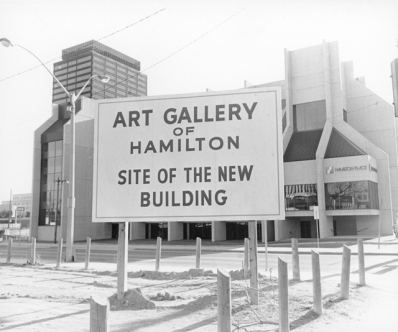The parking lot elevator at Terryberry Branch is not working. Members will need to use the accessible ramp at the Mohawk entrance and the inner elevator. We're working to get it fixed quickly.
Please note that the audio volume levels on our public computers are having issues. The estimated time of disruption is unknown at this time. Thank you for your patience.
As the 1st floor renovation wraps up, the Sherwood Branch will be closed on Thursday, June 5, to reset the spaces. Service hours will resume on Friday, June 6. Thank you for your patience.
Concession Branch's children's department will be closed on the morning of Monday, June 2nd for minor repairs. We apologize for the inconvenience.
The accessibility ramp at Mount Hope Branch is damaged. The handrail is not available. The ramp will not be available while being repaired. We aim to fix it quickly.
All HPL Branches are closed on Friday May 30 for Staff Development. Bookmobile is off the road and Extended Access is not available. HPL's online card registration, catalogue and eResources are not available until 5pm due to scheduled maintenance. All branches reopen Saturday May 31.
Due to the ongoing roof repair project, noise and parking disruptions are expected to continue until the end of June. Thank you for your patience.
Until Saturday May 31, the Ancaster Branch is temporarily relocated to the Ancaster Rotary Centre, 385 Jerseyville Road West, Ancaster. The Wilson Street branch is closed for a roof and HVAC replacement and is expected to reopen on Monday June 2 at 9am.
The digital microfilm machines at Central Library are not working. A single analog machine is available, but it doesn't print. We aim to have the digital devices repaired as soon as possible. We apologize for the inconvenience.
Please be aware of online phishing attempts impersonating Hamilton Public Library and Library Staff. HPL does not solicit paid freelance opportunities through social media or other messaging applications. HPL does not request personal or banking information through social media or require financial compensation when reviewing job applications. Please report phishing schemes to communications@hpl.ca. If you think you are a victim of fraud, please call the Canadian Anti-Fraud Centre at 1-888-495-8501.
Arts in Hamilton

The site of the Art Gallery of Hamilton, in 1974.

Hamilton Art School
1886 to 1890 - Canada Life Building (Birks Building)
Originally located in the Hamilton Provident and Loan Building, with Ida Banting as the school's first principal, the Hamilton Art School found a permanent home in the Canada Life Building in October of 1886.
Though now gone for decades, this building can still be recalled by many present-day Hamiltonians as the old Birk's building.
John Ireland was appointed the first head of the school after emigrating from England to take up the position in 1886. He was instructor to many of Hamilton's young artists, including J.E.H. MacDonald, who would go on to become a member of the Group of Seven.
The school, like similar institutions of the day, was modelled after the Royal School of Art in South Kensington, which had begun focusing on a national system of art training in 1853. John Ireland was an instructor at the RSA and bought to his new position an emphasis on teaching practical skills of draughtsmanship and design. Artists were trained to produce designs for manufacturing or for careers as public school art teachers. One of eight municipal art schools in Ontario at that time, the Hamilton Art School operated under the Ontario Department of Education and was funded by the City of Hamilton and private subscription.
1890 to 1909 - 2nd floor, Hamilton Public Library
Writers such as Stuart MacCuaig have attributed a cultural awakening in Hamilton to the Hamilton Art School. The school established itself between 1886 and 1909 by producing "a significant number of first-class artists who went on to attain great distinction in Canadian art." In 1903, John Ireland was replaced by American artist, Harry Neyland as head of the school.
Hamilton Collegiate Institute
In 1909, John Gordon succeeded Harry Neyland as the new principal of the Hamilton Art school. He agreed to amalgamation of the school with the Board of Education's technical school, which had recently opened in a wing of the Hamilton Collegiate Institute. It occupied one wing of the huge institute which was bound by the streets of Stinson, West, Hunter and Victoria. This new institute was named the Hamilton and Technical Art School. By 1919, enrollment had increased to the point that the technical portion of the school, including the arts, was relocated to its own building on Wentworth Street North. It was renamed the Hamilton Technical Institute in 1923.
Women's Art Association of Hamilton
The WAAH was formed in 1894 by founding members Sara Galbraith Calder, Clara Galbreaith, Florence Birely, Mrs. A.T. Freed, Aleda Burns and Mrs. Roland Hills. The WAAH is Hamilton's oldest continuous arts organization and is still a dominant force in the cultural fabric of Hamilton.
The Cabot Memorial Commemorative State Service
In 1897 the Women's Art Association of Canada proposed to mark the 400th anniversary of John Cabot's discovery of Canada by commissioning a hand-painted State Dinner Service for the Governor General's residence in Ottawa. Of the sixteen Canadian women artists chosen, two were members of the Women's Art Association of Hamilton, Clara E. Galbreaith and Alice M. Judd. Each of the sixteen artists painted twelve pieces of the service with depictions of Canadian historical moments, scenery, or flora and fauna. Twelve soup plates were painted by Clara Galbreaith and each depicts an historical landscape of Canada. Twelve dessert plates were painted by Alice Judd each with a different wild or cultivated fruit of Canada.
In 1898 after the finished service had been exhibited publicly in a number of different locations, it was presented to Lady Aberdeen whose husband the Earl of Aberdeen was about to end his term as Governor General of Canada. Thus the dinner service remains to this day at Haddo House, a Scottish National Trust property once the residence of Lady Aberdeen.
Hamilton Art School and The Group of Seven
The Hamilton Art School played an important early role in the lives of some of the Group of Seven's members. Founding member J.E.H. MacDonald received a substantial amount of his art training at the Hamilton Art School. A.J. Casson, a later member, worked during his early years at a commercial art company in Hamilton while studying on the weekends at the Hamilton Art School. Another artist, Hamilton native Albert Robertson, who was a contemporary of the Group of Seven, taught at the Hamilton Art School from 1905 to 1908.
Commercial Arts in Hamilton and the Artist's Union
When the Great Depression struck, it forced workers to realize how little control they exercised over the economic forces in which they worked. Artists were no different, especially commercial artists. They began to turn towards unionism as a means to secure their goals. In 1936, the first Artists' Union in Canada was organized in Toronto, and by 1937, Leonard Hutchinson formed the Hamilton local. The local's membership was comprised almost entirely of commercial artists.
Hamilton Illustrators
Many of the artists and illustrators that lived in Hamilton found work at one of any number of printing houses or commercial art firms that existed at the time. Companies like 'Davis and Lisson', 'Central Press', 'Laidlaw Lithographing Company', 'Commercial Engravers', 'Griffin and Richmond' and others were the training ground for many artists, commercial artists and illustrators. Hamilton produced a number of nationally and internationally renowned commercial illustrators.
Further reading and works cited in this article available at the Hamilton Public Library:
Bailey, Thomas Melville, Dictionary of Hamilton Biography, Vol. IV, 1999 (971.352 DIC V.4)
Bailey, Thomas Melville, HAMILTON Famous and Fascinating, 1972 (971.3521 BAI)
Dick-Lauder, Alma, Pen and Pencil Sketches of Wentworth Landmarks, 1897 (971.352 PEN)
Harper, J. Russell, Early Painters and Engravers in Canada, 1970 (709.71 HAR)
Hemming, Arthur, Spirit Lake, 1923 (HEM)
MacCuaig, Stuart, Climbing the Cold White Peaks : a survey of artists in and from Hamilton 1910-1950, 1986 (759.11352 MAC)











